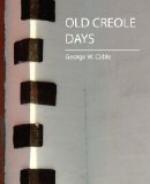He made his home in a room with one dormer window looking out, and somewhat down, upon a building opposite, which still stands, flush with the street, a century old. Its big, round-arched windows in a long, second-story row, are walled up, and two or three from time to time have had smaller windows let into them again, with odd little latticed peep-holes in their batten shutters. This had already been done when Kristian Koppig first began to look at them from his solitary dormer window.
All the features of the building lead me to guess that it is a remnant of the old Spanish Barracks, whose extensive structure fell by government sale into private hands a long time ago. At the end toward the swamp a great, oriental-looking passage is left, with an arched entrance, and a pair of ponderous wooden doors. You look at it, and almost see Count O’Reilly’s artillery come bumping and trundling out, and dash around into the ancient Plaza to bang away at King St. Charles’s birthday.
I do not know who lives there now. You might stand about on the opposite banquette for weeks and never find out. I suppose it is a residence, for it does not look like one. That is the rule in that region.
In the good old times of duels, and bagatelle-clubs, and theatre-balls, and Cayetano’s circus, Kristian Koppig rooming as described, there lived in the portion of this house, partly overhanging the archway, a palish handsome woman, by the name—or going by the name—of Madame John. You would hardly have thought of her being “colored.” Though fading, she was still of very attractive countenance, fine, rather severe features, nearly straight hair carefully kept, and that vivid black eye so peculiar to her kind. Her smile, which came and went with her talk, was sweet and exceedingly intelligent; and something told you, as you looked at her, that she was one who had had to learn a great deal in this troublesome life.
“But!”—the Creole lads in the street would say—“—her daughter!” and there would be lifting of arms, wringing of fingers, rolling of eyes, rounding of mouths, gaspings and clasping of hands. “So beautiful, beautiful, beautiful! White?—white like a water lily! White—like a magnolia!”
Applause would follow, and invocation of all the saints to witness.
And she could sing.
“Sing?” (disdainfully)—“if a mocking-bird can sing! Ha!”
They could not tell just how old she was; they “would give her about seventeen.”
Mother and daughter were very fond. The neighbors could hear them call each other pet names, and see them sitting together, sewing, talking happily to each other in the unceasing French way, and see them go out and come in together on their little tasks and errands. “’Tite Poulette,” the daughter was called; she never went out alone.
And who was this Madame John?
“Why, you know!—she was”—said the wig-maker at the corner to Kristian Koppig—“I’ll tell you. You know?—she was”—and the rest atomized off in a rasping whisper. She was the best yellow-fever nurse in a thousand yards round; but that is not what the wig-maker said.




